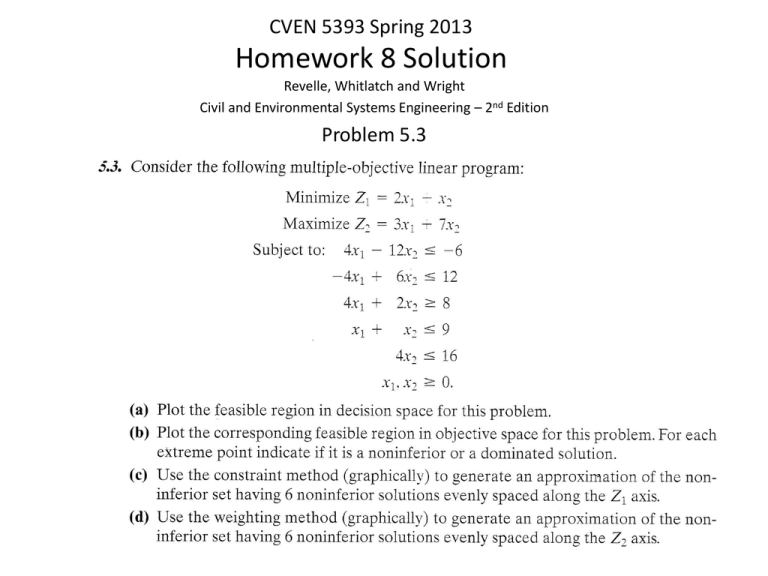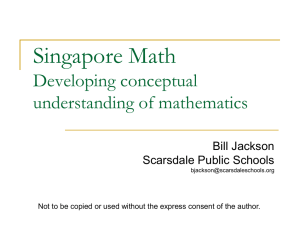Homework 8 Solution - Civil, Environmental, and Architectural
advertisement

CVEN 5393 Spring 2013 Homework 8 Solution Revelle, Whitlatch and Wright Civil and Environmental Systems Engineering – 2nd Edition Problem 5.3 a) Plot feasible region in decision space 4x1 - 12x2 <= -6 -4x1 + 6x2 <= 12 4x1 + 2x2 >= 8 x1 + x2 <= 9 4x2 <= 16 b) Plot the corresponding feasible region in objective space. For each extreme point indicate if it is a noninferior or dominated solution Max Z2 Min Z1 Z2 A B C D E X1 1.50 0.75 3.00 5.00 6.38 X2 1.00 2.50 4.00 4.00 2.63 Z1 4.00 4.00 10.00 14.00 15.38 Z2 11.50 19.75 37.00 43.00 37.50 dominated noninferior noninferior noninferior dominated Z1 C. Use the constraint method (graphically) to generate an approximation of the noninferior set having 6 noninferior solutions evenly spaced along the Z1 axis. Construct a payoff table. Each row represents the solution of one individual objective function, and shows the values for the other objects at that point. If alternate optima are detected, compare the values of other objectives to select the noninferior point. Every point in the payoff table is a noninferior solution. The table gives the entire range of values each objective can have on the noninferior set. Solution X1 X2 Z1 = 2x1 + x2 min Z2 = 3x1 + 7x2 max Z1 Optima 1.5 .75 1.0 2.5 4.0 4.0 11.50 19.75 A B Z2 Optima 5.0 4.0 14.0 43.00 D Need 6 noninferior solutions evenly spaced along the Z1 axis Max is 14; Min is 4.0 Other 4 points are 6, 8, 10, 12 Create constrained problem by selecting one of the objectives to optimize and moving the other(s) into the constraint set with the addition of a right hand side coefficient for each. 4 additional constraints to add to the problem, one at a time and find optimal solution for Z2: 2X1 + X2 <= 6 2X1 + X2 <= 8 2X1 + X2 <= 10 2X1 + X2 <= 12 - - X2 Add each additional constraint to the set and find the optimal solution for the remaining objective. Each solution- is a noninferior solution of the multiobjective problem. Decision Space 4x1 - 12x2 <= -6 Series1 10 -4x1 + 6x2 <= 12 - 2x + x <= 12 Series2 1 2 4x1 + 2x2 >= 8 9 Series3 x1 + x2 <= 9 2x1 + x2 <= 10 2x1 + x2 <= 14 8 Series4 4x2 <= 16 Series5 2x1 + x2 <= 6 7 2x1 + x2 <= 8 New constraint set: 6 2X1 + X2 <= 6 2X1 + X2 <= 8 5 - - 2X1 + X2 <= 10 2x1 + x2 <= 6 - - 2X1 + X2 <= 12 4 - - Noninferior Solutions 3 - - X1 X2 Z1 Z2 2 0.75 2.50 4.00 19.75 1.50 3.00 6.00 25.50 Max 3X + 7X 1 2 2.25 3.50 8.00 31.25 1 3.00 4.00 10.00 37.00 4.00 4.00 12.00 40.00 0 5.00 4.00 14.00 43.00 0 4 6 8 10 12 - 2 X1 - c) The selection of the Z1 points gave the same solution for the pareto front as we got in a) and b). If we had not used as many Z1 points we may have gotten some approximation errors. Max Z2 Min Z1 Z2 A B C D E X1 1.50 0.75 3.00 5.00 6.38 X1 0.75 1.50 2.25 3.00 4.00 5.00 X2 1.00 2.50 4.00 4.00 2.63 X2 2.50 3.00 3.50 4.00 4.00 4.00 Z1 4.00 4.00 10.00 14.00 15.38 Z1 4.00 6.00 8.00 10.00 12.00 14.00 Z2 11.50 19.75 37.00 43.00 37.50 dominated noninferior noninferior noninferior dominated Z2 19.75 25.50 31.25 37.00 40.00 43.00 Z1 d.) Use the weighting method (graphically) to generate an approximiation of the noninferior set having 6 noninferior solutions evenly spaced along the Z2 axis. What is range of Z2 point? We know this from the payoff table. Z2 ranges from 19.75 to 43.0. Six evenly space values are: Z2 = 19.75; 24.40; 29.05; 33.70; 38.35; 43.0 To solve: use the weighting method to identify noninferior points in objective space. Then interpolate between these to find the value of noninferior points at the designated Z2 values. Note that since Z1 is a minimization objective and Z2 is a max objective, we must make Z1 also a max objective by taking the negative of it. We arbitrarily select a set of weights and compute the Grand Objective: grad ient w1 w2 w1*(-)Z1 + w2*Z2 Grand objective 1 1.0 0 1.0 * (-2x1 – x2) + 0*(3x1+7x2) Max -2x1 – x2 2 0.8 0.2 0.8 * (-2x1 – x2) + 0.2*(3x1+7x2) Max -x1 + 0.6x2 3 0.6 0.4 0.6 * (-2x1 – x2) + 0.4*(3x1+7x2) Max 2.2x2 4 0.4 0.6 0.4 * (-2x1 – x2) + 0.6*(3x1+7x2) Max x1 + 3.8x2 5 0.2 0.8 0.2 * (-2x1 – x2) + 0.8*(3x1+7x2) Max 2.0x1 + 5.4x2 6 0 1.0 0 * (-2x1 – x2) + 1.0*(3x1+7x2) Max 3x1 + 7x2 d) Solve single grand objectives 4x1 - 12x2 <= -6 -4x1 + 6x2 <= 12 4x1 + 2x2 >= 8 x1 + x2 <= 9 4x2 <= 16 Gr Objective 1 -2x1 – x2 2 -x1 + 0.6x2 3 2.2x2 4 x1 + 3.8x2 5 2.0x1 + 5.4x2 6 3x1 + 7x2 Solution A,B B C,D D D D x1 x2 Z1 Z2 0.75 2.5 4.0 19.75 0.75 2.5 4.0 19.75 3.0 5.0 5.0 5.0 5.0 4.0 10.0 37.0 4.0 14.0 43.0 4.0 14.0 43.0 4.0 14.0 43.0 4.0 14.0 43.0 b) Use linear interpolation to find the noninferior points at Z2 = 19.75; 24.40; 29.05; 33.70; 38.35; 43.0 50 45 14, 43 40 10.9, 38.35 10, 37 Z2 19.75 24.40 29.05 33.70 38.35 43.00 Z1 4.0 5.62 7.64 8.85 10.9 14.0 35 8.85, 33.7 Z2 30 7.64, 29.05 25 5.62, 24.4 20 Series1 4, 19.75 15 10 5 0 0 5 10 Z1 15 Things to keep in mind The “classical” methods of solving multi-objective optimization problems are based on creating a set of single objective optimization problems, each of which identifies a non-inferior solution. The set forms a pareto front or surface (if more than 2-d). Other solutions can be inferred by interpolation if the variables are continuous. If you have a plot of extreme points in objective space, you can identify the noninferior extreme points by the relative values of the objectives or by the “corner” rule. The NE corner rule depends on sign of objectives The payoff table identifies the range of values that each objective can have.






